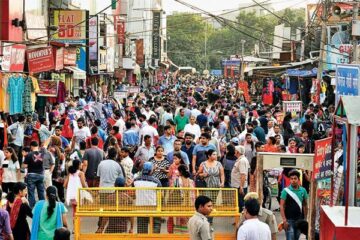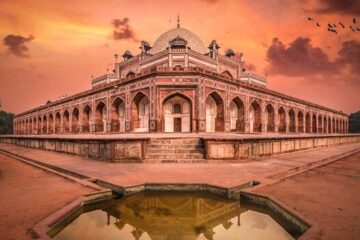Lodhi Garden
In the centre of Delhi is a large green park called Lodhi Gardens. Along with other buildings, it contains the mausoleums of Mohammed Shah and Sikander Lodhi, two emperors of the Delhi Sultanate. The garden and the buildings inside it, with their striking architecture and stunning natural beauty, are a reflection of the nation’s capital’s turbulent past. Lodhi Gardens is one of Delhi’s top tourist destinations because of its tranquil green surroundings and about 500 years of architectural history. Be careful to reserve your accommodations in Delhi in a location that allows you quick access to this verdant haven.
Are you interested in learning more about Delhi’s historic garden? All the information, such as the history, architecture, schedule, cost of admission, and sights to be seen at Lodhi, is available on this blog.
Lodhi Garden, Delhi Information:
| Location | Lodhi Estate, New Delhi |
| Type | City Park |
| Formerly Known as | Lady Willingdon Park |
| Origins | 1444 |
| Area | 90 acres |
| Timings | 5:00 am to 8:00 pm (April to September); 6:00 am to 8:00 pm (October to March) |
| Entry Fee | Free |
| Still/Video Camera | Free |
| Nearest Metro Station | Jorbagh Metro Station and Lok Kalyan Marg Metro Station |
Lodhi Gardens: History
The history of Lodhi Garden, also known as Lodhi Garden, dates back to 1444, when King Mohammed Shah of the Delhi Sultanate during the Sayyid Dynasty had his mausoleum built here by his son Ala-ud-din Alam Shah, who further He later became the last emperor of the dynasty. The tomb of Sikandar Lodi, a prominent figure of the Lodi dynasty, built by his son Ibrahim Lodi in 1517, is located nearby. During the control of the Sayyids and Lodis, several additional buildings were also constructed at this location. During his reign, Emperor Akbar used the Lodhi Garden area as an observatory and housed documents in a library specially built for that purpose.
The area around these tombs eventually gave rise to two communities. The people were not moved out until 1936, when the British took it over, so that the garden could be renovated. The area was landscaped and transformed into a beautiful garden by Lady Willingdon, wife of the Marquess of Willingdon, who was then the Governor General of India. In 1936, the garden was formally opened and named Lady Willingdon Park in honor of her contribution.
After the country’s independence in 1947, its name was changed to Lodhi Garden. An American architect named Joseph Stein redesigned the layout of the garden and added a glasshouse to it in 1968.
Lodhi Gardens Architecture
Spread over more than 90 acres, Lodhi Gardens is home to several architecturally stunning buildings dating back to the 15th century. The tomb of Mohammed Shah is built in both Hindu and Islamic architectural styles. The mausoleum is wonderful to behold, composed of eight small domed buildings or chhatris, each decorated with lotus petals, elaborate pinnacles at the corners, a massive central dome and an octagonal chamber.
The tomb of Mohammed Shah served as inspiration for the tomb of Sikandar Lodi. It was constructed in the Indo-Islamic architectural style and has an octagonal layout without chhatris and a central dome. The tomb is a closed structure with a domed entrance and the walls are decorated with Mughal architectural patterns. It is considered to be the first closed garden tomb of India.
Lodhi Gardens: Today
Nowadays, one of the most important historical places of Delhi is Lodhi Garden. Local joggers, morning walkers and yoga lovers also love this place. Moreover, this garden is a favorite picnic spot for families, and couples in Delhi love to spend romantic evenings there due to its serene environment.
The park has over 100 different types of trees, over 50 different species of birds and butterflies, and a 15th-century mausoleum. The garden is currently maintained by the Archaeological Survey of India. The National Bonsai Park is a small part of the garden that has been set aside. The garden is used by many Delhi-based clubs and organizations for heritage walks.
Things to See in Lodhi Gardens
In addition to the tombs of the two Sultans, there are several more structures worth seeing, including:
Bada Gumbad, also known as Bade Gumbad, is a massive dome made of rubble that was reportedly constructed by Sikandar Lodi in 1490.
The three-domed mosque in the Bada Gumbad complex is known as the Sheesha Gumbad or Glazed Dome, and it is believed that Ibrahim Lodi built the mausoleum, which is tiled with blue enamel.
Athapula, also known as the Eight Pier Bridge, is a stunning 16th century stone bridge that was built under Emperor Akbar. It has seven arches and eight pillars that support it.
a body of water
a glass house
National Park for Bonsai
Lesser Known Facts about Lodhi Garden
- There’s one that dates back to the British era that is still operational.
- The gardens contain one hundred different species of trees, all of which have QR tags attached by the New Delhi Municipal Council to deter anyone from felling them.
Attractions near Lodhi Gardens
- Khan Market (1.2 km)
- Purana Qila (2.6 km)
- National Handicrafts and Handlooms Museum (2.8 km)
- Rashtrapati Bhavan (3.1 km)
- Humayun’s Tomb (3.1 km)
- National Zoological Park (3.2 km)
- Safdarjung Tomb (3.7 km)
- India Gate (3.8 km)
- Connaught Place (4.5 km)
- Jantar Mantar (4.6 km)
- Dilli Haat (5.4 km)
Delhi’s Lodi Gardens is a great spot to spend some time in a traditional environment. When you’ve had enough of the park’s attractions, visit the adjacent Khan Market and go shopping all you want. Another highlight is the Lodi—the Garden Restaurant, which is located next to Gate No. 1 and offers delicious outdoor dining.



1 Comment
Delhi's Qutub Minar: History, Hours, Admission Charge, and Details · May 28, 2024 at 2:45 pm
[…] Lodhi Garden, Delhi: Information, History, Timings, and Entry Fee […]